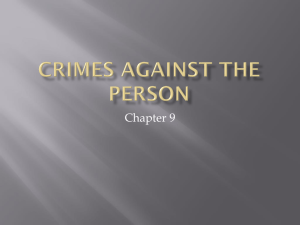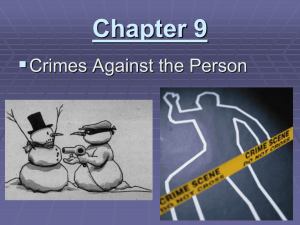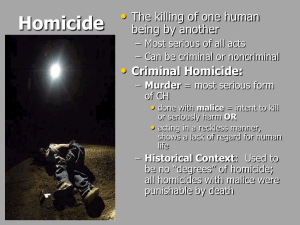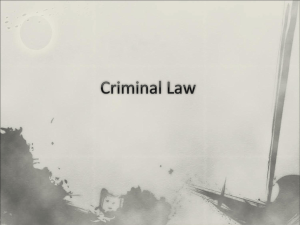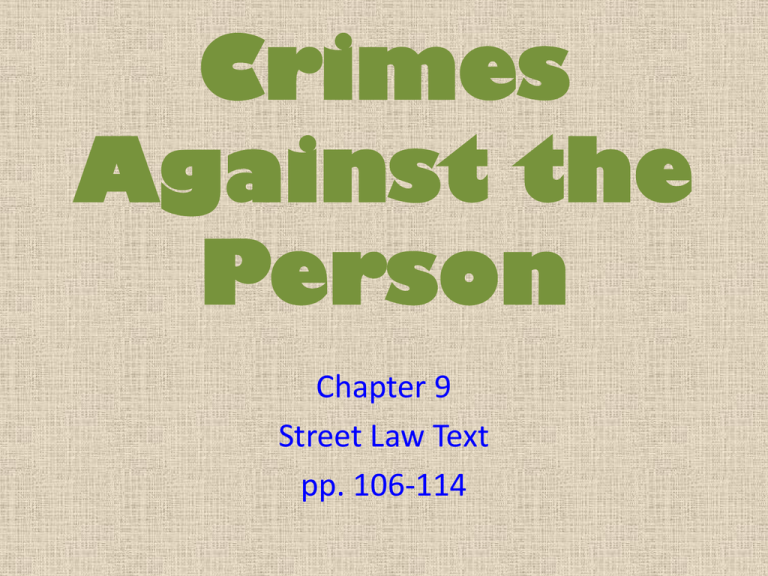
Crimes
Against the
Person
Chapter 9
Street Law Text
pp. 106-114
• Crimes against the person include homicide,
kidnapping, assault, battery, and sexual
assault.
• These are considered some of the most
serious crimes in our society thus there are
protections not only for the victim but also the
accused.
• Each “crime against the person” is usually
broken down into levels of seriousness.
Homicide
Homicide is the killing of one human being by
another.
It is the most serious of all crimes, but can be
classified as criminal or non-criminal.
Criminal Homicide is committed with intent, and
possibly a plan. As well as committing a reckless
or negligent act that takes a life.
Non-Criminal Homicide is “excusable” or
“justifiable”.
Criminal Homicide
Murder is the most serious type of criminal homicide.
Murder is
killing that is done with Malice- the intent to kill or seriously harm
a person, or acting in an extremely reckless manner, that shows
no regard for human life.
Most states have laws that classify murder according to the
killer’s state of mind or the circumstances surrounding the crime.
First Degree Murder- killing that was Premeditated- thought
about beforehand [planned], deliberate, and done with malice.
Also known as Capital Murder, because the death penalty is an
option in many states.
Felony Murder- killing that takes place during the commission of
certain felonies. Examples would be arson, rape, robbery, or
burglary. There is no need to prove intent to kill. Most state
consider Felony Murder First Degree Murder.
Criminal Homicide Cont.
Second Degree Murder- killing that is done with malice, but
without premeditation or deliberation. Intent to kill did not exist
until the moment of the murder, spontaneous killings that are
unplanned.
Voluntary Manslaughter- killing that would otherwise be seen as
murder but that occurs after the victim has done something to
the killer that would cause a reasonable person to lose self
control or act rashly. The killing must occur before a “cooling off”
period.
Involuntary Manslaughter- killing in which there is no intent to
kill at all. Usually from reckless conduct.
Negligent Homicide- causing death through criminal negligence.
Negligence- failure to exercise a reasonable or ordinary amount
of care in a situation that causes harm. Vehicular Homicide.
You Be the Judge p. 109
Read each of the following accounts carefully. For each one, determine who can be
charged with the crime of homicide and the degree of homicide for which he or she
should be charged. Give reasons for your answers.
a. Walt decides to shoot his ex-girlfriend Yolanda, whom he blames for all his
troubles. As he is driving to her home to carry out the murder, he accidentally hits a
jogger who darted out into the road from behind a tree. Stopping immediately, Walt
rushes to help the jogger, who is already dead. Assume that Walt was driving at a
safe speed and that the collision with the jogger was unavoidable.
b. Belva is cheated when she buys a car from Fast Eddie’s Car Mart. She attempts
to return the car, but Eddie just laughs and tells her to go away. Every time Belva
has to make a repair on the car, she gets angry. Finally, she decides to wreck Eddie’s
car to get even with him. Following him home from work one evening, Belva tries
to ram his car, hoping to bend the axle or frame. Instead of bending the frame, the
collision smashes Eddie’s gas tank, causes an explosion, and kills him.
c. Alison and Brad need money to pay their bills and decide to rob a bank. Brad
drives the getaway car. Alison goes into the bank and pulls out her gun, announcing,
“This is a stickup. Don’t move!” The bank guard, Gordon, shoots at Alison but
misses, killing Dawn, a bank customer.
Homicide in Nebraska
Murder in the First Degree class I felony [Death] or
Class IA felony [Life in prison] intentional, with malice,
and premeditated
Murder in the Second Degree class IB felony [Max=
Life, Min= 25yrs] intentional without premeditation
Manslaughter class III felony [Max= 20yrs, Min= 1yr]
without malice, upon sudden quarrel, or
unintentionally while committing an unlawful act
Motor Vehicle Homicide class I misdemeanor [Max=
no more than a year, Min= Nothing] unintentionally
when in violation of the motor vehicle law of Nebraska
or any county or city
A class IIIA felony [Max= 5yrs, Min= Nothing] reckless,
willful reckless driving, or DUI
A class III felony [Max= 25 years, Min= 1yr] previous
conviction of DUI
Non-Criminal Homicide
Killing that is justifiable or excusable, the killer is
deemed faultless.
Examples:
Killing an enemy soldier in wartime
Execution of condemned criminal
Killing of a criminal by a police officer in the line of duty
Self Defense or Defense of another person
Suicide
Suicide- the deliberate taking of one’s own life.
Was once considered a crime [think about that]. Today
most states make attempted suicide a crime, so that they
can try to help the individual.
In the United States a suicide takes place, on average, every
15 minutes.
Even though many people will have the thought enter their
minds sometime in life, very few will actually carry out this
act.
There are many agencies, hotlines, and counselors that are
available to help those in emotional and or physical need.
Always remember suicide is almost always a very selfish
act…. It usually only leaves great despair behind, and
sometimes great loathing of the individual that commits it.
Problem 9.1
“The Case of the Dying Cancer Patient”
a. Was Wilfred’s request related to suicide? Explain.
b. If you were the district attorney in the state where Martha lives,
would you file criminal charges against her? Explain.
c. If manslaughter charges were filed and you were on the jury,
would you vote to convict Martha? Give your reasons. If Martha
were convicted, what sentence should she receive? Why?
d. If the bottle of pills had been given to Wilfred by a physician
instead of by his wife, would your answers have been different?
Give your reasons.
e. If you were a state legislator, would you be in favor of or against a
law allowing assisted suicide? Explain.
Suicide in Nebraska
• No Statute found for attempted suicide
• Assisted Suicide is a class IV felony [Max=5 yrs,
Min= Nothing]
Kidnapping
Kidnapping/ Unlawful Imprisonment/
Abduction- taking away a person against their
will.
An age old crime that originally referred to
stealing children, obviously today it refers to
anyone taken against their will.
In NEBRASKA:
Kidnapping is a class I A felony [life imprisonment]
If the victim was voluntarily released unharmed class II
felony [Max= 50yrs, Min= 1yr]
False Imprisonment first degree class III A felony [Max= 5yrs,
Min= Nothing] second degree class I misdemeanor [Max= not
more than 1 yr, Min= Nothing]
Assault and Battery
Assault- any attempt or threat to carry out a physical attack
upon another person
Battery- any unlawful physical contact inflicted by one person
upon another person without consent
Usually these words are used interchangeably today.
There are different classes or degrees of assault and battery just
like in homicides.
Stalking- when a person repeatedly follows or harasses another
person and makes threats, causing the victim to fear death or
bodily injury. Cyberstalking- harassment using electronic
communications.
Bullying- peers or acquaintances intimidate, or put a person in
fear of injury. One study showed that 60% of indentified bullies
in grades 6-9 had been convicted of at least one crime by age 24.
Bullying is seen by many as a “gateway” crime.
Sexual Assault and Rape
Sexual Assault- unwelcome sexual contact or sexual verbal
threats against another.
Both Men and Women are capable of committing and being
victims of sexual assault.
Rape- sexual intercourse without consent.
Statutory Rape- intercourse with someone under the legal age of
consent.
Criminal Sexual Assault- simply sexual assault
Acquaintance Rape [date rape]- sexual assault by someone
known to the victim… usually not a separate crime from rape
[sexual assault]
Problem 9.2
For each case below, assume that the two people have sexual intercourse. Assume that the
police find out about the sexual activity in each instance. How should each situation be handled?
a. At midnight, a man breaks into the home of a woman he does not know. He
goes to her bedroom, awakens her, pulls out a knife, and threatens to stab her
unless she has sex with him. She tells him that she does not want to have sex. But
then she says, “If you are going to do this, you’d better use a condom.” He agrees.
b. A famous boxer serves as a judge at a beauty contest. After the contest, he
invites an 18 year old contestant to his hotel room. She meets him there. Later, she
says he forced her to have sex.
c. A male high school student, aged 17, and a female high school student, aged
14, go out on a date. After attending a party, they agree to have intercourse in his
car. The legal age of consent in this state is 16. The next day, he brags about this at
school, and she goes to the police. There is some evidence that he is part of an
informal organization of high school boys who are involved in a competition to
have sex with as many girls as possible.
d. Leo and Nina are college juniors who have had three dates. On these dates they
have never engaged in any sexual activity beyond a brief good night kiss. On their
fourth date, he invites her to an all night drinking party at his fraternity house. She
drinks too much, goes up to his room alone around 1:00 am, and falls asleep. In
the morning, she wakes up to discover that she and Leo had intercourse during the
night.
Sexual Assault in Nebraska
Sexual Assault in the 3rd degree class I misdemeanor
[Max= not more than a year, Min= Nothing] no
penetration, contact without consent or unable to
consent, DID NOT cause serious personal injury
Sexual Assault in the 2nd degree class III felony [Max=
20yrs, Min= 1yr] no penetration, contact without
consent or unable to consent, DID cause serious
personal injury
Sexual Assault in the 1st degree class II felony [Max=
50yrs, Min= 1 yr] sexual penetration without
consent, unable to consent, or when actor is 19 or
older and victim is at least 12 but less than 16

